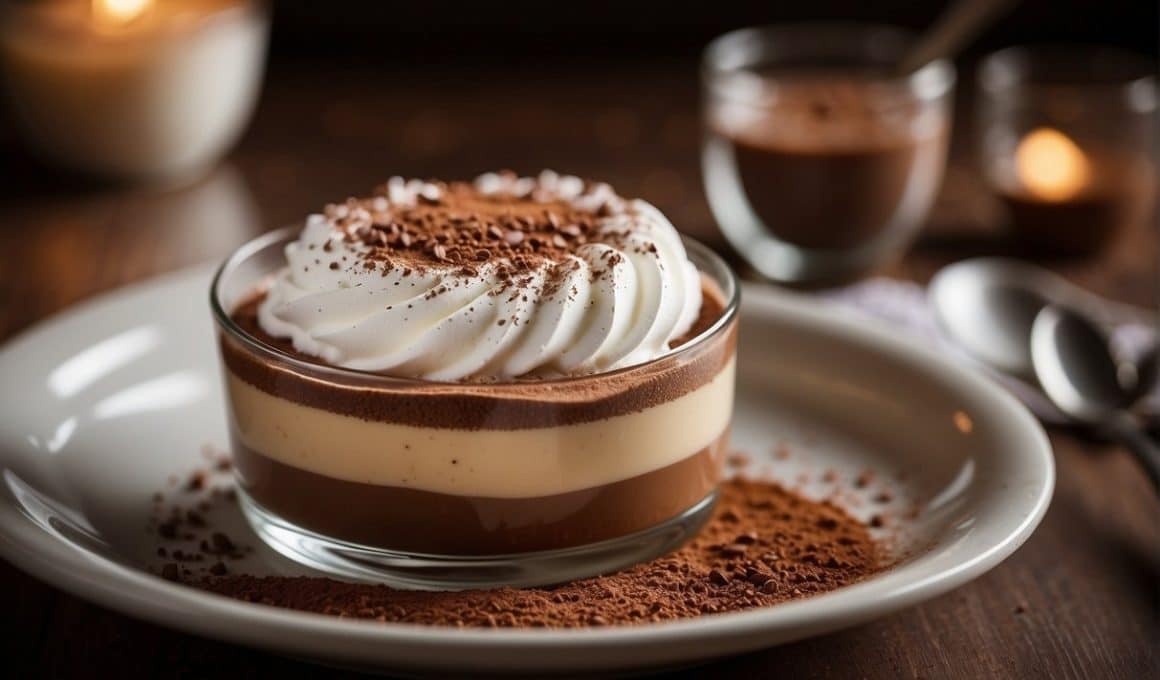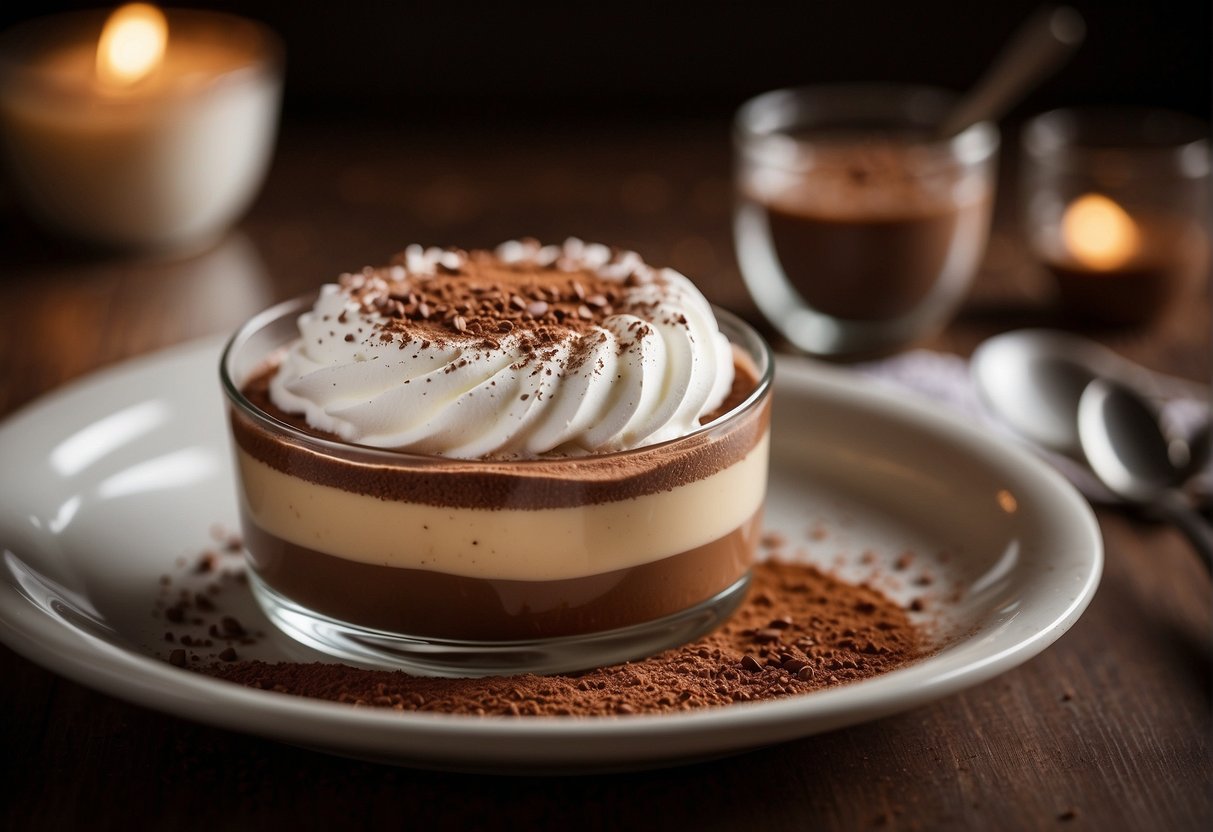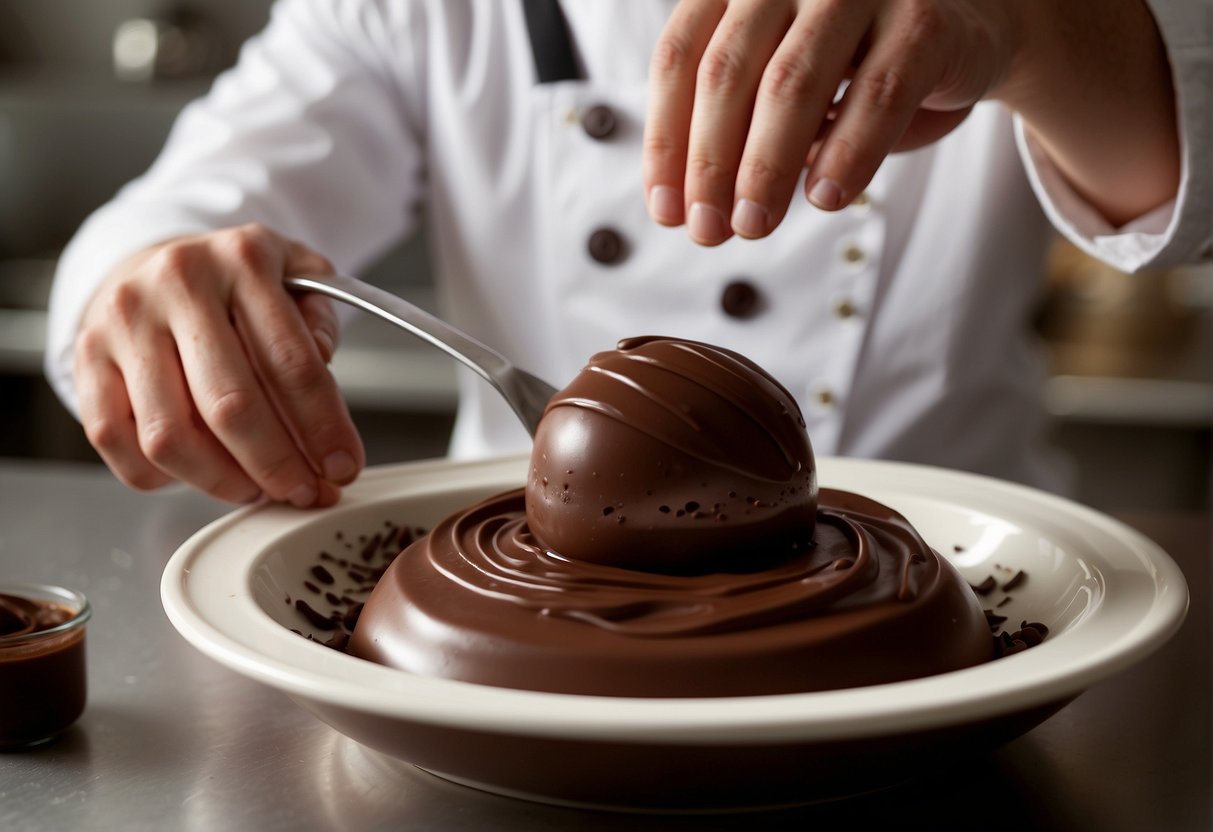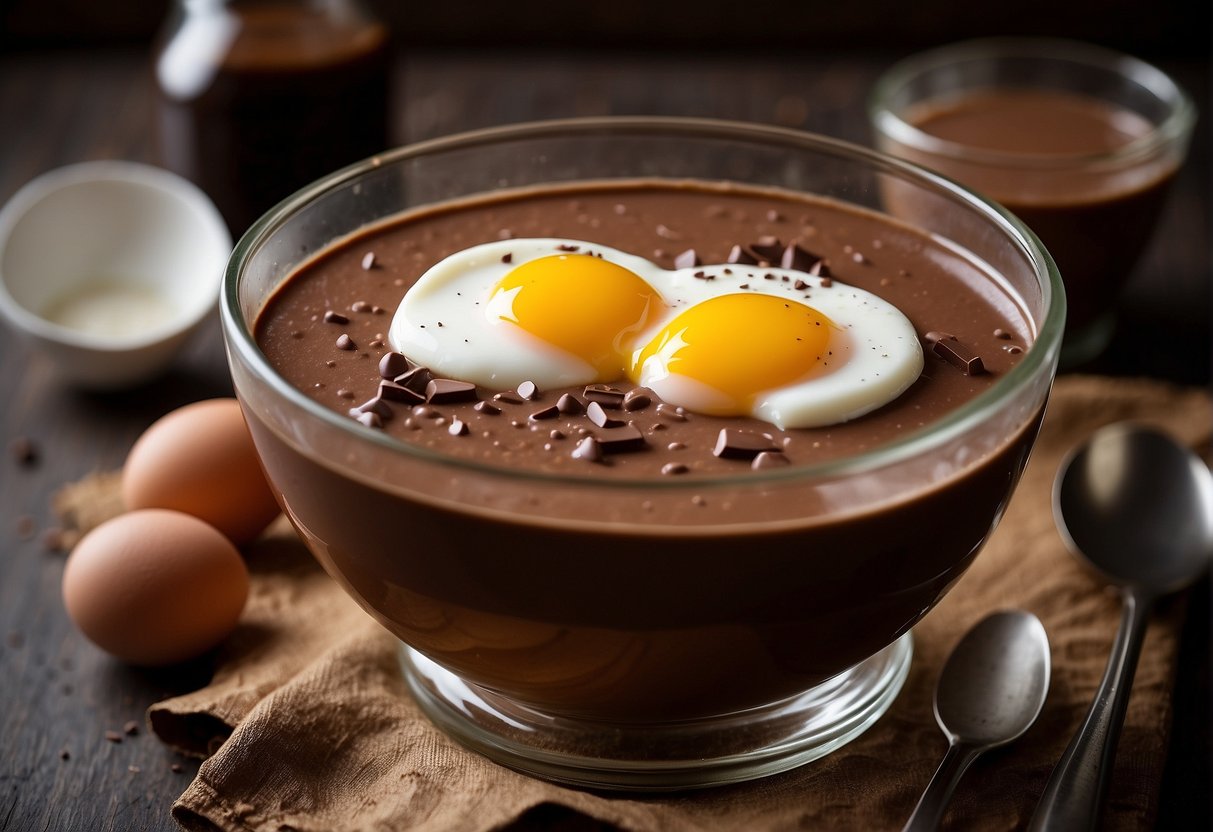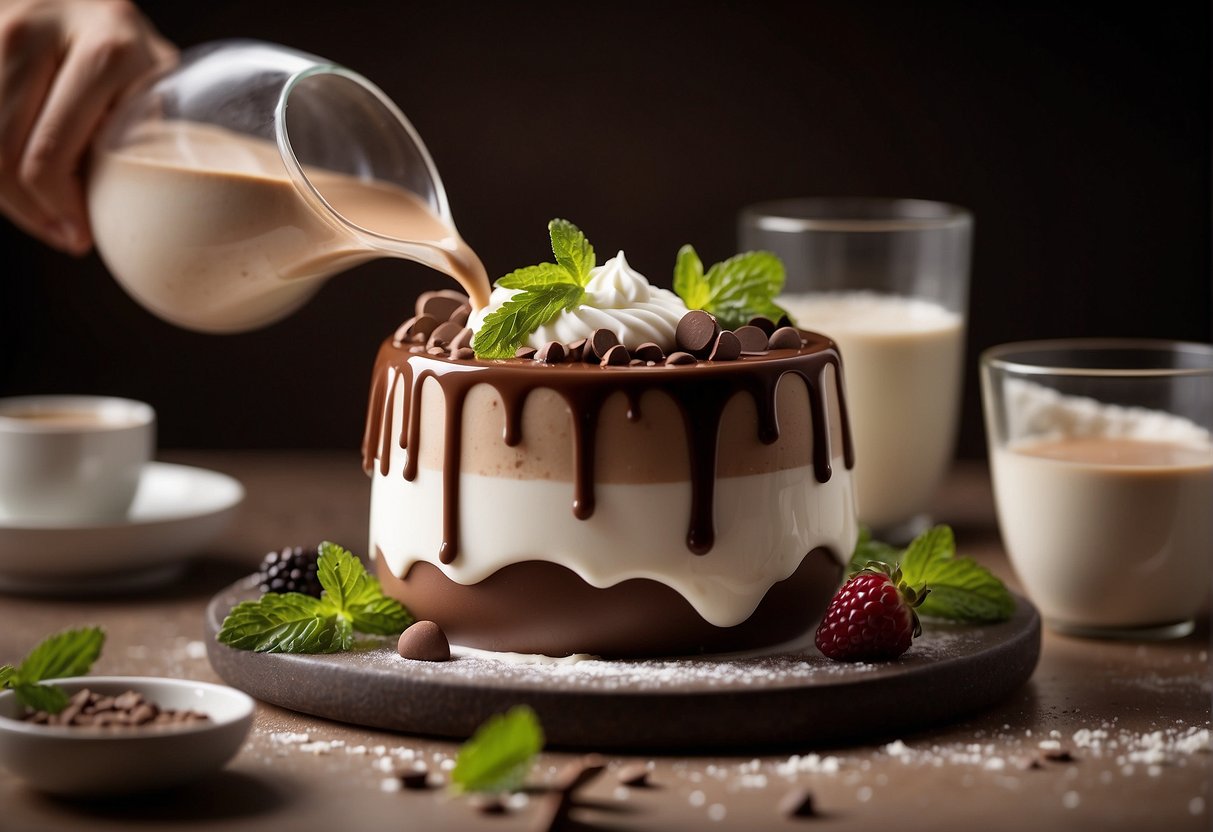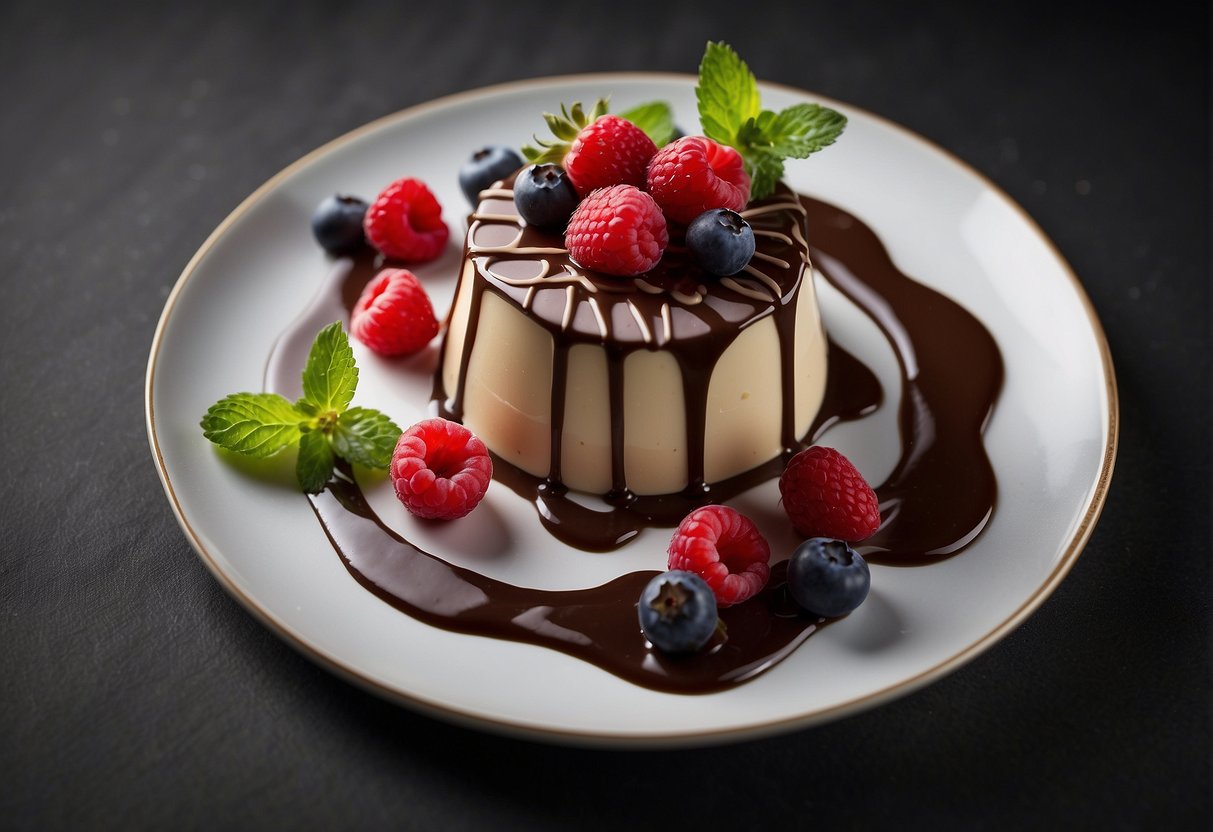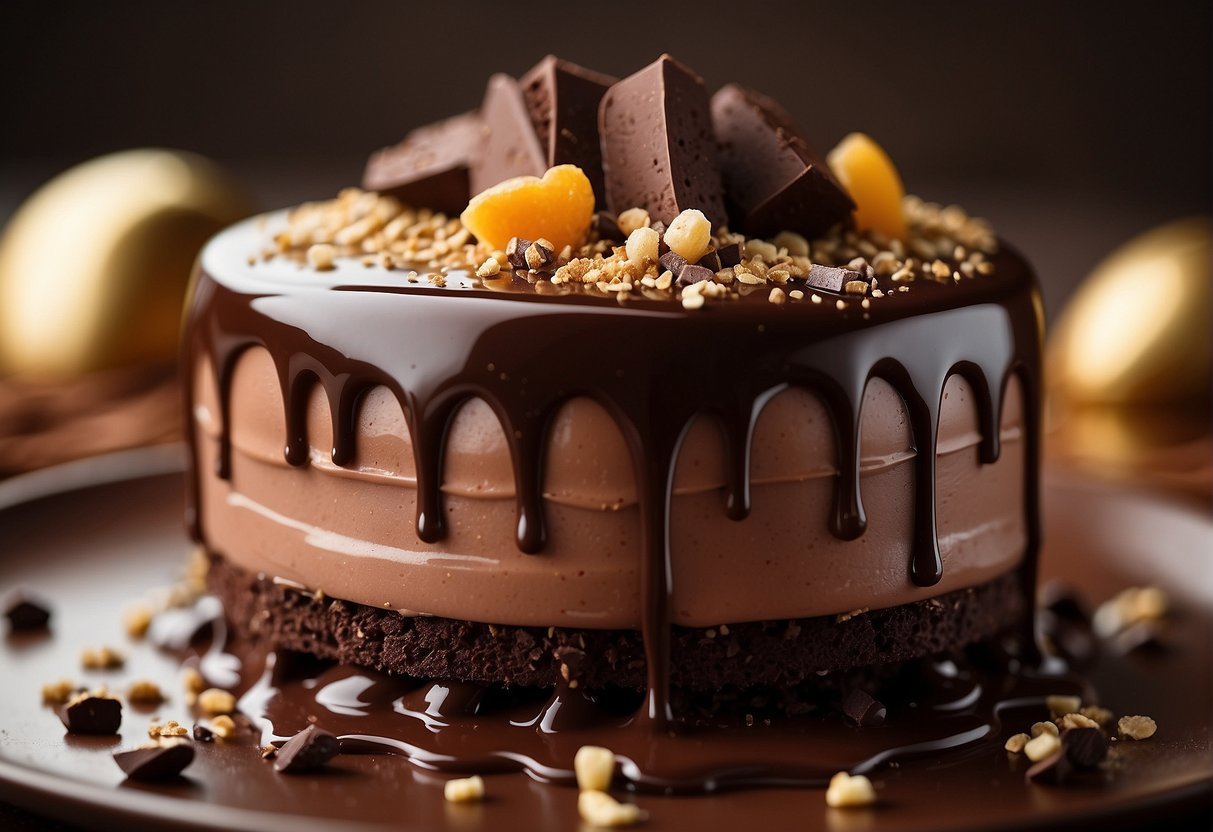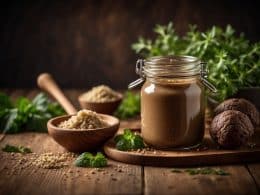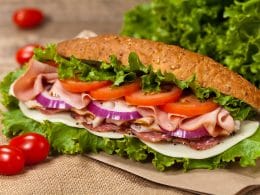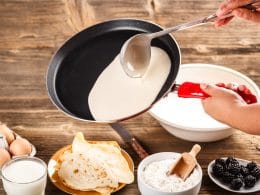Chocolate bavarois is a classic French dessert that offers a luxurious combination of creamy texture and rich flavor. As a silky, mousse-like custard, I understand it to be a pinnacle of delicate dessert craftsmanship. Enticingly smooth, bavarois captures the essence of chocolate in a form that’s both opulent and feather-light, making it a favored choice for those in search of a sophisticated finale to their meal.
My experience with this dessert has taught me that the key to a perfect chocolate bavarois lies in its base ingredients: milk, eggs, sugar, and chocolate. The process involves creating a custard, incorporating the chocolate, and then setting the mixture with gelatin before it’s lovingly chilled to achieve the desired consistency. Presentation is as important as the preparation—serving chocolate bavarois can be an opportunity to showcase one’s creativity, often accompanied by fruit coulis, whipped cream, or various garnishes that complement its richness.
Key Takeaways
- Chocolate bavarois, a sumptuous French dessert, strikes a balance between richness and delicacy.
- Mastery of fundamental ingredients and techniques is essential to achieve its signature texture.
- Presentation and accompaniments are key to enhancing the bavarois, elevating it to a gourmet experience.
History and Origin
The Bavarian cream dessert, known as bavarois, links its prestigious roots to the region of Bavaria and later underwent a French transformation, evolving into what many gourmet enthusiasts recognize as crème bavaroise.
Origins in Bavaria
The tale of bavarois begins in Bavaria, a culturally rich region in Germany. Historical accounts suggest the dessert’s origin dates back to the 17th and 18th centuries, an era when opulent French cuisine was highly sought after by Bavarian royalty. The creamy dessert’s development is believed to have coincided with the period when French chefs were employed by the Wittelsbach princes, the reigning dynasty of Bavaria at that time. This royal patronage may have been instrumental in the inception of this indulgent creation.
French Adaptation
As the delectable bavarois traversed borders into France, it underwent a culinary evolution, possibly including the refinements of legendary French chef Marie-Antoine Carême, known for his contributions to the art of French cooking in the 19th century. The French adaptation, which I refer to as crème bavaroise, is reminiscent of the original, albeit with the sophisticated touch typical of French desserts. It retains the rich and smooth characteristics that are the hallmark of the original Bavarian dessert while embodying the finesse expected of French pâtisserie.
Basic Ingredients
In crafting a delectable chocolate bavarois, I pay meticulous attention to the selection of basic ingredients. They function as the foundation, influencing the texture, flavor, and overall quality of the dessert.
Chocolate Types
Dark Chocolate: I prefer using dark chocolate with a cocoa content ranging from 55% to 75% for a rich and deep chocolate essence in the bavarois. Plain or semi-sweet varieties work wonderfully.
Dairy Components
- Milk: A creamy layer in the dessert can be achieved by utilizing whole milk or semi-skimmed milk.
- Cream: For the luxurious texture synonymous with bavarois, I incorporate heavy cream or double cream, ensuring it has a high-fat content for stability.
Thickening Agents
The firm yet delicate consistency of chocolate bavarois is formed with the aid of:
- Gelatine: Essential for setting the dessert, I use gelatine leaves or powder, depending on the recipe’s demand.
- Egg Yolks: They act as an emulsifier and provide a rich custard base when gently cooked with milk and sugar.
Sweeteners and Flavorings
For an impeccable balance of sweetness and flavor, these two components are key:
- Sugar: I use caster sugar because of its fine granules that dissolve quickly and create a smooth texture.
- Vanilla: A hint of vanilla enhances the chocolate’s complexity without overpowering the flavor profile. Vanilla pods or quality extract can be used.
Chocolate Bavarois Recipe
Creating a chocolate bavarois involves a series of meticulous steps to achieve its splendidly smooth and creamy texture. From the preparation of the custard base to the final chilling process, each step is essential to crafting this luxurious dessert.
Preparation
I begin by gathering all the necessary ingredients for my chocolate bavarois. It includes:
- Milk & Cream: To infuse flavor and richness.
- Egg Yolks: The foundation of the custard.
- Sugar: For sweetness and texture balance.
- Dark Chocolate: The key feature that provides a rich and intense flavor.
- Agar Agar or Gelatin: To help set the dessert properly.
I measure out each ingredient with precision: milk and cream in ml, egg yolks are counted, sugar in grams, and chocolate based on cups or percentage of cocoa content.
Cooking Process
The custard is the heart of the dessert. I heat the milk and cream until hot but not boiling. Then, I whisk the egg yolks and sugar until pale before slowly incorporating the hot mixture to them. I return it to the heat and stir continuously until thickened, ensuring not to let it boil. Once it coats the back of a spoon, I pass it through a fine sieve to remove any lumps. Then, I stir in melted dark chocolate until the mixture is homogeneous.
Assembly Instructions
I prepare my moulds by lightly greasing them for easy unmolding later. I mix the sieved custard with the dissolved agar agar or gelatin. Once it’s slightly cooled, but still pourable, I evenly distribute it into the moulds.
Chilling and Serving
I set my bavarois in the fridge for at least 4-6 hours, allowing the mixture to firm up into its iconic silky texture. To serve, I carefully unmould the bavarois onto plates and garnish with whipped cream or chocolate shavings. This dessert can be a showstopping finish to any meal or a stand-alone treat for a sweet craving.
Variations of Chocolate Bavarois
In my experience, chocolate bavarois can be customized in a multitude of ways, from incorporating fruits to adapting for dietary restrictions. I will guide you through some of the most enticing variations I’ve encountered.
Fruit Infusions
Adding fruit to chocolate bavarois not only imparts a complementary flavor but also introduces a bright and refreshing contrast to the rich dessert. I often infuse the cream with fruit purees such as strawberry or raspberry before it’s combined with the chocolate. This technique ensures that the fruit flavors are seamlessly integrated throughout the dessert.
- Strawberry Chocolate Bavarois: Mix pureed strawberries into the bavarois base for a summer-ripe taste.
- Raspberry Chocolate Bavarois: Fold in a raspberry reduction to achieve a tart twist on the classic chocolate flavor.
Texture Variations
Manipulating texture can turn a simple chocolate bavarois into an intriguing dish with a complex mouthfeel. Here are a couple of texture twists I enjoy:
- Choco Crunch Bavarois: Introduce a layer of crushed chocolate cookies or cocoa nibs between the bavarois layers for a crunchy surprise.
- Velvet Chocolate Bavarois: Top the bavarois with a chocolate velvet spray to lend a velvety texture that melts in the mouth.
Dietary Adaptations
I always consider dietary preferences and restrictions when crafting chocolate bavarois. Vegetarians and those looking for gelatin-free options can benefit from the use of agar agar, a plant-based gelatin substitute that sets the bavarois effectively.
- Vegetarian Chocolate Bavarois: Utilize agar agar instead of gelatin to cater to vegetarian guests without compromising on texture.
- White Chocolate Variations: Substitute dark chocolate with white chocolate for a sweeter, creamier bavarois that still honors the classic dessert’s texture.
Techniques and Tips
When creating a chocolate bavarois, mastery in specific techniques can greatly impact the final product. Precision is key, and I always recommend paying close attention to how you melt chocolate, whip cream, and incorporate gelatin to achieve that quintessential aerated texture and flawless taste.
Melting Chocolate
My go-to method for melting chocolate involves a double boiler, where I can gently coax the chocolate to a smooth consistency without scorching it. I ensure water does not touch the bottom of the chocolate bowl and maintain a gentle simmer to avoid creating steam that could seize the chocolate. The goal is silky-smooth, fluid chocolate that will integrate well into the bavarois mix.
Whipping Cream
The secret to perfect whipped cream lies in its temperature and equipment: cold cream and a chilled bowl. I start at a low speed and gradually increase to medium-high, stopping once stiff peaks form. It’s crucial not to over-whip, as the cream can become grainy and butter-like. Well-whipped cream is fundamental to the bavarois’s light, aerated texture.
Incorporating Gelatin
Gelatin is the setting agent for a bavarois, and I ensure it’s properly dissolved and cooled before use. For seamless incorporation, I whisk gelatin into a portion of the base mixture to temper it, then fold it into the main batch. This method prevents gelatin lumps and ensures an even set throughout the dessert. Remember, the key is a smooth blend to maintain the desirable consistency of the bavarois.
Pairings and Presentation
In my experience, presenting and pairing a chocolate bavarois is just as important as its preparation. The right accompaniments and presentation techniques can transform this pudding into a memorable dessert, especially for special occasions.
Serving Suggestions
When I serve chocolate bavarois, I find that portion control is key for a sophisticated presentation, especially on special occasions. I often opt for individual servings using elegant glassware that showcases the dessert’s layers and textures. For a more traditional approach, a single, larger set in a decorative mold that’s then sliced is equally impressive. Chocolate bavarois pairs excellently with a hot cup of coffee; its bitterness balances the dessert’s richness, enhancing the chocolate flavor.
Complementary Flavors
Chocolate bavarois is rich and creamy, so I like to introduce contrasting flavors. A berry coulis drizzled on top or around the dessert adds a tart brightness that complements the chocolate. Alternatively, garnishing with fresh berries or other fresh fruit like sliced kiwi or mango not only adds color but also a refreshing taste contrast which cuts through the creaminess of the pudding.
Decorating Techniques
I adhere to the principle that less is more when decorating a chocolate bavarois. A simple dusting of cocoa powder or chocolate shavings can be elegant. For a more elaborate touch, tempered chocolate can be crafted into shapes or curls for a professional finish. When I’m aiming for a pop of color, edible flowers or a sprig of mint add a beautiful contrast without overwhelming the dessert.
Culinary Considerations
When making a chocolate bavarois, the quality of the chocolate and its preservation are paramount. I’ll guide you through the essential aspects of selecting the finest chocolate and ensuring its taste remains optimal over time.
Selecting Quality Chocolate
For the best chocolate bavarois, I always recommend using the finest Belgian chocolate or single origin chocolate. Finest Belgian chocolate is renowned for its superior quality and consistent flavor profile, which can elevate the dessert’s taste. Single origin chocolate allows for a unique taste experience, where each variety offers a distinct flavor and character tied to its region of origin. Remember, a higher cocoa content ranging from 55% to 75% enhances the richness of your bavarois.
Storage and Shelf Life
After preparing your chocolate bavarois, storage is critical to maintain freshness and texture. Here’s how to store it effectively:
- Refrigerator: Keep your bavarois in the refrigerator for up to 3 days. Store it in an airtight container to prevent it from absorbing other food odors.
- Freezer: If you need to store it longer, the freezer is an option. Wrap the bavarois tightly with cling film or place it in a freezer-safe container. It can be kept for about 1 month. Always let it thaw in the refrigerator for a few hours before serving to ensure the texture remains silky smooth.
Professional Use
In my professional culinary experience, mastering the use of chocolate bavarois demands attention to its fluidity for molding and consistency for plating. I’ve seen its versatility in different settings from elegant restaurants to high-end patisseries, with applications ranging from fillings to standalone desserts.
Restaurant Applications
When I incorporate chocolate bavarois in a restaurant setting, it’s essential to consider its role as a luxurious dessert item. To ensure perfect presentation every time:
- Fluidity: Chocolate must be melted to the right fluidity before blending into the bavarois mixture, allowing for a smooth finish in the final product.
- Silicone Molds: I often utilize silicone molds to shape the bavarois, which ensures a consistent and professional presentation that’s crucial for restaurant service.
- Packaging: If the bavarois is part of a takeaway or delivery option, sturdy packaging that maintains the integrity of the dessert is paramount.
Chocolate in Patisserie
In my own patisserie applications, chocolate bavarois has multiple uses:
- Pastries: As a bavarian cream filling, it provides a rich, chocolatey heart to éclairs and cream puffs, often whipped to be light yet stable.
- Emulsify: I make certain to properly emulsify the chocolate mixture to prevent separation, which is vitally important for the texture and shelf life of patisserie items.
- Whip Up: The ability to whip up the mixture properly affects the bavarois’s lightness, a key quality for layered patisserie desserts.
By focusing on these technical aspects, I craft chocolate bavarois that is as delightful to eat as it is to behold.
Frequently Asked Questions
In this section, I’ll address some of the most common inquiries about chocolate bavarois, ranging from preparation to distinguishing it from similar desserts.
How do you make a chocolate bavarois dessert?
To make a chocolate bavarois, I start by creating a custard base with milk, egg yolks, and sugar, then melt chocolate into the mixture. Once cooled, I fold in whipped cream and set it with gelatin. This process creates a dessert with a creamy and rich texture.
Can you explain the steps for creating a chocolate bavarois cake?
Creating a chocolate bavarois cake involves preparing a spongy base, typically a genoise or joconde, and then layering it with the chocolate bavarois mixture. I ensure that the bavarois sets by chilling it in the fridge before finishing with a glaze or garnish.
What are the differences between a chocolate mousse and a chocolate bavarois?
The key difference between a chocolate mousse and a chocolate bavarois is the setting agent. In a mousse, I rely on the whipped cream and egg whites to give it a light texture. In contrast, a bavarois includes gelatin, which helps it to set more firmly and makes it suitable for layered desserts.
Why is a chocolate bavarois also known as a chocolate Bavarian cream?
Chocolate bavarois is also called chocolate Bavarian cream because it originated in Bavaria. It maintains the traditional method of setting custard with gelatin and incorporates whipped cream, giving it a luxuriously smooth texture reminiscent of French and Bavarian patisserie techniques.
How does white chocolate bavarois differ from regular chocolate bavarois?
White chocolate bavarois differs from regular chocolate bavarois primarily in flavor. I use white chocolate which has a sweeter, subtler taste and lacks the cocoa solids that give dark chocolate bavarois its intense chocolate flavor.
What distinguishes a bavarois from a panna cotta in terms of texture and ingredients?
The main distinctions between a bavarois and a panna cotta are texture and preparation. A bavarois, which I make with whipped cream, has a mousse-like texture, while panna cotta is silkier and more custard-like because it’s made by simmering cream, milk, and sugar with gelatin.





